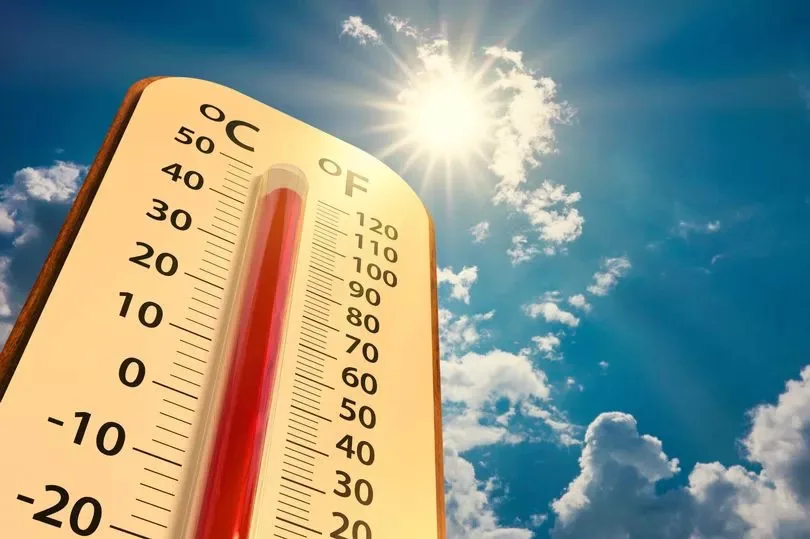“Scorching Summer: Understanding the UK’s Latest Heatwave and How to Beat the Heat”
UK Heatwave Weather Forecast: Causes, Risks, and Precautionary Measures
As summer peaks, the UK is currently experiencing a significant heatwave, with temperatures forecasted to reach as high as 34°C in some regions. This weather phenomenon is part of a broader pattern of rising temperatures across Europe, driven by climatic and atmospheric changes. This article delves into the reasons behind the UK heatwave, its potential impacts, and the essential precautions that should be taken during this period.
The Current UK Heatwave Forecast
According to recent reports, the UK is in the midst of a brief yet intense heatwave. The weather forecast indicates that temperatures will spike, especially in London, the southeast, and parts of the Midlands, peaking around Sunday, August 11th, and Monday, August 12th. This surge in heat is primarily due to a high-pressure system that has settled over the region, drawing in warm air from southern Europe and North Africa.

However, the heatwave is not expected to last long. As the week progresses, temperatures will begin to drop, and the high pressure is likely to be replaced by cooler air and thunderstorms. Despite the brief nature of this heatwave, the impacts can still be severe, particularly for vulnerable populations such as the elderly, young children, and those with pre-existing health conditions.
Causes of the UK Heatwave
The current heatwave is the result of a combination of atmospheric and climatic factors. Heatwaves in the UK are often caused by high-pressure systems that become stationary over the country, creating a dome of hot, dry air. This setup prevents cooler air from the Atlantic from reaching the UK, leading to prolonged periods of high temperatures.
Moreover, climate change is playing an increasingly significant role in the frequency and intensity of heatwaves. The UK has experienced its warmest years on record since 2002, with each year bringing more frequent and prolonged hot spells. As global temperatures rise due to the accumulation of greenhouse gases, the likelihood of extreme weather events like heatwaves also increases.
In addition, the current heatwave is linked to broader weather patterns across Europe, where several countries are also experiencing higher-than-average temperatures. This is partly due to the jet stream, which is positioned further north than usual, allowing high pressure to dominate the UK’s weather.
Potential Risks and Health Impacts
While sunny weather can be a welcome change, heatwaves carry several risks. Prolonged exposure to high temperatures can lead to heat-related illnesses such as heat exhaustion and heatstroke. These conditions are particularly dangerous for the elderly, infants, and individuals with chronic health issues. The UK Health Security Agency has issued a Yellow Heat Health Alert, highlighting the need for extra caution during this period.
Heatwaves can also exacerbate existing respiratory and cardiovascular conditions. High temperatures, combined with increased humidity, can make breathing difficult and put extra strain on the heart. Additionally, heatwaves often lead to poorer air quality, as pollutants become trapped in the warm air, contributing to the development of smog, especially in urban areas.
Beyond health risks, heatwaves can also have broader societal impacts. Infrastructure, such as roads and railways, can suffer from the extreme heat, leading to delays and disruptions. In agricultural areas, crops can become stressed, affecting yields and potentially leading to food shortages.

Precautionary Measures During the Heatwave
Given the significant risks associated with heatwaves, it is essential to take appropriate precautions to stay safe and healthy. Here are some recommended measures:
- Stay Hydrated: Drink plenty of water throughout the day, even if you don’t feel thirsty. Avoid alcohol and caffeinated beverages, as these can lead to dehydration.
- Limit Sun Exposure: Avoid being outdoors during the hottest parts of the day, typically between 11 a.m. and 3 p.m. If you need to be outside, wear lightweight, loose-fitting clothing, and a wide-brimmed hat.
- Use Sunscreen: Protect your skin by applying sunscreen with a high SPF. Sunburn can occur quickly in extreme heat, increasing the risk of skin cancer.
- Keep Indoor Spaces Cool: Close curtains and blinds during the day to keep the sun out. If possible, use fans or air conditioning to maintain a comfortable indoor temperature.
- Check on Vulnerable Individuals: Ensure that elderly neighbors, young children, and those with health conditions are staying cool and hydrated. Heatwaves can be especially dangerous for these groups.
- Be Prepared for Thunderstorms: As the heatwave breaks, thunderstorms are likely. These can bring heavy rain, strong winds, and lightning, so it’s important to stay informed and avoid outdoor activities during stormy weather.
Conclusion
The current UK heatwave serves as a reminder of the growing impact of climate change on weather patterns. As the country faces increasingly frequent and intense heatwaves, understanding the causes, risks, and necessary precautions becomes crucial. While the current heatwave may be brief, it still poses significant health risks, particularly for vulnerable populations.
By staying informed and taking appropriate measures, individuals can mitigate the dangers of extreme heat while still enjoying the summer weather. As the climate continues to change, it is likely that heatwaves will become more common in the UK, making preparedness and awareness more important than ever.






